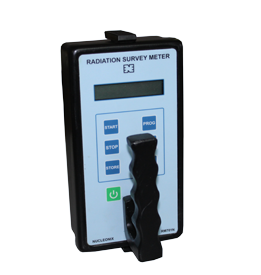HEALTH PHYSICS INSTUMENTATION FOR
IMPORTANT DEFINITIONS OF RADIATION UNITS
Absorbed dose :
The energy transferred to a material by ionising radiation per unit mass of the material.
Unit : J kg-1; Name of unit : Gray (see also Rad)
Activity : Measurement of quantity of radioactive material. It is the number of nuclear
transformations or isomeric transitions per unit time.
Unit : s-1 Name of unit : Becquerel (see also Curie)
Alpha decay :
A radioactive conversion accompanied by the emission of an alpha particle. In alpha decay the atomic number is reduced by 2 and the mass number by 4. Test ones own luck can be a cube gameplay. Alpha decay occurs, with a few exceptions, only for nuclides with a proton number exceeding 82.
Alpha radiation :
Radiation that consists of high energy helium (4He) nuclei emitted during alpha disintegration of atomic nuclei. Alpha particles possess discrete initial energies (line spectra) which are characteristic of the emitting nuclide.
Becquerel (Bq) :
Name of the derived SI unit of activity. Number of radioactive transformations or isometric transitions per seconds s-1 = Bq.
1 Bq = 27 x 10-12 = 27 pCi
1 kBq = 27 x 10-9 = 27 nCi
1 MBq = 27 x 10-6 = 27 mCi
1 GBq = 27 x 10-3 = 27 mCi
1 TBq = 27 Ci = 27 Ci
Beta decay :
Radioactive conversion accompanied by the emission of a beta particle, i.e. a negatively charged electron (b- decay) or a positively charged electron ((b+ decay). When a negatively charged electron is emitted, a neutron in the atomic nucleus is converted to a proton with the simultaneous emission of an antineutrino, so that the proton number Z is increased by 1. When a positively charged electron (positron) is emitted, a proton in the nucleus is converted to a neutron with simultaneous emission of a neutrino, so that the proton number Z is decreased by 1.
Beta Radiation :
Radiation that consists of negative or positive electrons which are emitted from nuclei undergoing decay. Since the decay energy (or, if it is followed by gamma radiation, the decay energy less that photons energy) is statistically divided between beta particles and neutrinos (or antineutrinos), the energy spectrum of beta radiation is continuous, extending from zero to a maximum value characteristic of the nuclide concerned. The maximum beta energy is generally termed the “beta end-point energy of the nuclide”.
Bremsstrahlung :
Radiation that results from the acceleration / deceleration of charged particles in the Coulomb field of atoms.
Curie (Ci) :
Name for derived unit of activity. One Curie corresponds to 3.7 x 1010 nuclear disintegrations or isomeric transitions per second 1 CW = 3.7 x 1010 s-1.
1 Ci = 37 GBq
1 mCi = 37 MB1
1 mCi = 37 kBq
1 nCi = 37 Bq
1 pCi = 37 mBq
Dose :
See absorbed dose, exposure value, and dose equivalent.
Dose equivalent :
A term used in radiation protection for the radiation dose. It is the product of absorbed dose times the quality factor.
Unit : J kg-1; Name of unit: Sievert (see also Rem).
Dose rate :
Dose absorbed per unit time.
Electron radiation:
Particle emission consisting of negatively or positively charged electrons.
Exposure dose:
The ratio of the amount of electric charge of the ions of one polarity that are formed in air by ionising radiation and the mass of the air. Unit : C. kg-1 (see also Roentgen).
Gamma radiation:
Photon radiation emitted by an excited atomic nucleus decaying to a lower energy state. Gamma radiation has a line spectrum with photon energies which are specific to the nuclide concerned. Gamma and X-rays are both electromagnetic radiation and they are distinguished only by their mode of generation.
Gray:
The SI unit of absorbed radiation dose. 1 Gray of absorbed dose corresponds to 1 joule of energy per kilogram of mass. 1 Gray = 100 rad
Half-thickness:
The thickness of material layer that reduces the intensity of initial radiation by a factor of two.
Ionising radiation:
Radiation that consists of particles capable of ionising a gas.
Isotopes:
Nuclides with the same atomic number but different atomic weights. (Mass numbers)
Mass per unit area:
Product of the density of a material and its thickness.
Nuclide :
Generic term for neutral atoms that are characterized by a specific number of neutrons N and protons Z in the nucleus.
Quality factor :
A factor which in radiation, protection allows for the effects of different types of radiations and energies on people.
Rad (Radiation Absorbed Dose):
An old unit used to measure absorbed radiation dose. 1 Rad of absorbed dose corresponds to 0.01 joule of energy per kilogram of mass (=100 ergs of energy per gram of mass).
All measurements of absorbed dose depend on the absorbing medium as well as the level of radiation. 1R is equivalent to 0.871 rad in air.
RBE (Relative Biological Effectiveness)
The biological effect of radiation depends, not only on the energy absorbed, but also on the radiation concerned. To illustrate, the effect of 1 Gray of X-ray will be quite different from the effect of 1 Gray of neutrons. The RBE is an attempt to compensate for this variation and may be considered as a weighting factor for different type of radiation. RBE (for radiation of Energy E) is defined as the ratio; (Dose of 200 keV gamma rays producing a given biological effect) divided by (dose of radiation of energy E producing the same effect).
Radioactivity :
The property which certain nuclides have of emitting radiation as a result of spontaneous transitions in their nuclei.
Rem (Roentgen Equivalent Man) :
The rem is an early unit used to measure the effect of a given type of radiation on living tissue, including compensation for the type of radiation involved. rem dose = rad dose x RBE.
Roentgen-R :
An old unit used to measure radiation by it’s ability to ionise ari. 1 Roentgen is that amount of radiation which releases a charge of 258 microcoulomb per kilogram of air. This measure is a specific quantity of radition, but does not relate to the absorption by materials.
Sievert (Sv) :
This is the SI unit used to measure the effect of a given type of radiation on living tissue, including compensation for the type of radiation involved 1 Sievert = 100 Rem.
H* (10) :
(Normally pronounced “H-Star-Ten”) This is the Ambient Dose Equivalent and is applicable to strongly penetrating radiation in environmental and area monitoring. The exact definition is complex (defined in ICRU Report 39), but relates generally to the effect of the radiation at a depth of 10 min in human tissue.






